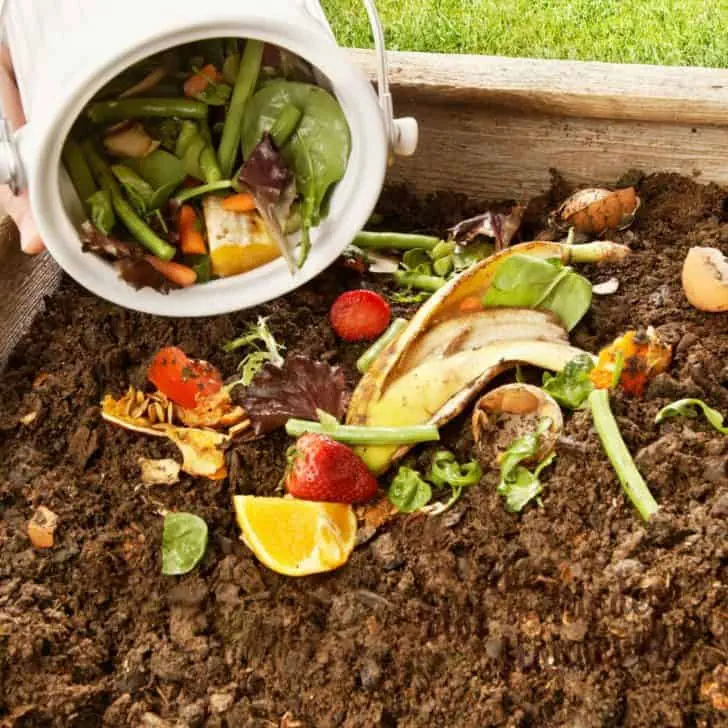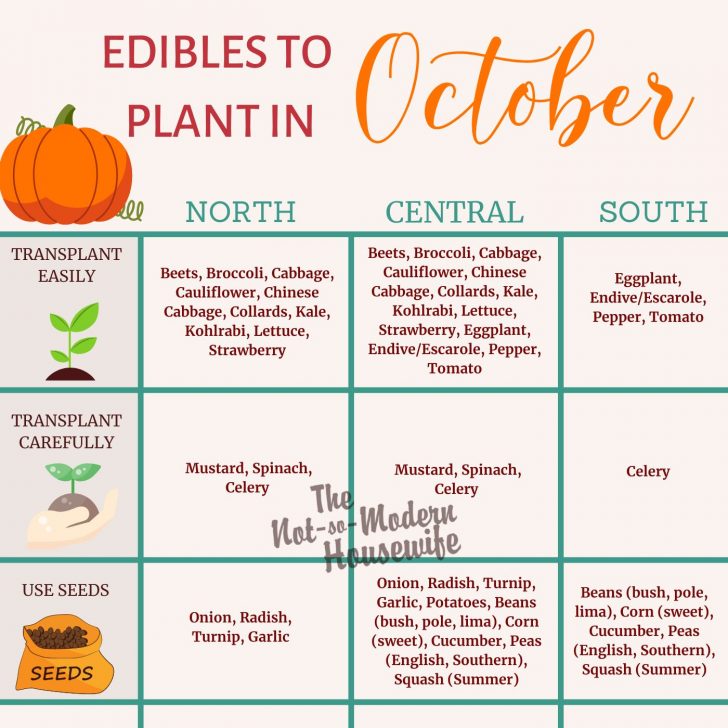As autumn rolls in and the weather starts to cool down, it’s the perfect time for Florida gardeners to consider what to plant in Florida in October.
This is the time to embrace the delightful world of planting cool-season vegetables and herbs. Get ready to immerse yourself in the joy of discovering the best plants that thrive in the diverse regions of Florida.
From the vibrant panhandle to the sunny peninsula, you’ll find tailored advice to create a flourishing garden no matter where you are.
And that’s not all!
We’ll also share some invaluable gardening tips that will elevate your gardening game to new heights. So get ready to dig in and unlock the secrets to a bountiful and beautiful Florida garden!
Table of Contents

October Weather Patterns in Florida
October marks the beginning of the biggest growing season in Florida, where nature’s bounty flourishes. As the temperatures gradually cool down, creating a mild and pleasant climate, a diverse range of vegetables thrive in these ideal weather conditions.
When night falls, something magical happens that greatly impacts seed germination – the temperature drops. Each seed has a preferred temperature range for germination. For cool-season vegetables and herbs, the chilly October nights are just perfect for them to sprout and grow their best.
As the sun sets and the earth cools, the drop in temperature signals the seeds that it’s time to start sprouting. This temperature fluctuation between day and night is exactly what the seeds need to break dormancy and begin germination.
So, as you tuck into bed each night, your garden gets to work, capitalizing on the cooler temperatures to trigger the miracle of life beneath the soil. It’s nature’s way of ensuring that your garden thrives, even when you’re not watching. This is why understanding and taking advantage of this natural process is a garden game-changer, especially in the milder October climate of Florida.
Beginning of Cool-Season Crops
Cool-season crops, which thrive in the cooler temperatures of autumn, are a fantastic choice for a bountiful harvest. Some great examples of these crops include nutrient-rich broccoli, versatile cauliflower, vibrant spinach, hearty kale, brussels sprouts, and cabbage carrots. By incorporating these vegetables into your fall garden, you can enjoy a continuous supply of fresh produce throughout the colder months.
Root vegetables, like carrots and radishes, are also a great choice for the fall season. Since they grow underground, their quality is unaffected by colder fall temperatures. This makes them an excellent option for growing in the Florida October climate.
Planting from Seed
Starting your garden from seed is not just an economical choice, but it also opens up a world of possibilities. When you choose to purchase seed packets, you’ll find that the cost per plant is significantly less than buying grown plants from a nursery or garden center. This savings can be quite substantial, especially if you’re planning a large garden.
In addition to monetary savings, growing from seed allows you to select from a wider variety of plants. Seed catalogs offer a vast array of options, many of which you won’t typically find in a local nursery. This means you can grow unique and exotic varieties that stand out from the usual offerings.
Starting a garden from seeds isn’t as daunting as it might seem. Here are some tips to help get you started:
Choose the Right Seeds:
Choosing seed varieties that are adapted to your growing region is a crucial aspect of successful gardening. This is because plants have adapted over many years to thrive under specific conditions — think soil type, daylight length, and temperature ranges. When we match plants to their preferred environment, they’re naturally more robust and resilient.
In Florida, for example, the tropical and subtropical climate creates a unique growing environment. Certain varieties of plants have been bred to tolerate the heat, humidity, and specific pests that are prevalent in the state. Choosing these varieties can make your gardening experience more rewarding, as you’ll likely have healthier plants and bigger harvests.
Use Good Soil:
Before planting, take the time to prepare the soil, ensuring it is nutrient-rich and well-drained. Adding organic material like compost, manure, or peat moss will help to improve the soil structure and provide necessary nutrients.
In addition, testing your soil’s nutrient levels can be beneficial. The University of Florida offers soil testing through your local County Extension office.
Plant at the Right Time:
Timing your planting is crucial for successful gardening, especially here in Florida. We’re lucky to have warm temperatures and long growing seasons that let us grow crops all year round. But to make sure everything thrives, we’ve got to be smart about when we plant certain things.
Now, when it comes to Florida, the weather changes can mess with our lawn and gardening plans, especially between the beginning and end of October. We might still see some lingering hurricane activity, with heavy rains and strong winds. And boy, it gets humid! But don’t worry, as the month goes on, things start to cool down a bit.
By mid-October, we’re in for some drier and cooler weather. That’s when Florida’s dry season kicks in, and it feels so much nicer outside. We’re looking at daytime highs in the mid-70s to mid-80s (in Fahrenheit), and nights can drop into the low 60s or even high 50s in some parts of the state.
All these weather changes give us some great opportunities to grow different crops. But, hey, we’ve got to stay on top of it and plan our planting schedule accordingly. That way, our plants can thrive in these shifting conditions. So, for example, if you’re into cooler-weather crops like broccoli, lettuce, and radishes, save them for the latter part of October.
Remember, gardening in Florida can be a real adventure, but with a little know-how and some careful planning, we can make the most of it. Happy planting, folks!
Provide Adequate Sunlight and Water:
Sunlight is important for seed germination and plant health. It’s the main source of energy for photosynthesis, where plants convert sunlight, carbon dioxide, and water into glucose for growth and even release oxygen.
When the seedlings start to emerge, photosynthesis becomes even more vital. Sunlight stimulates chlorophyll production, which means more energy conversion, stronger stems, and bigger leaves.
But hey, here’s a pro tip: make sure to gradually expose your seedlings to full sunlight. You don’t want them to get sunburned, right? We call this process ‘hardening off’ and it’s important for their optimal growth.
Oh, and speaking of optimal growth, keeping the soil evenly moist is a key factor. Water is the magic potion that activates enzymes and kick-starts plant growth. It also helps maintain a consistent soil temperature, which is essential for successful germination.
Just remember, too much or too little moisture can mess things up, so aim for that perfect balance. You want the soil to be evenly moist, but not waterlogged. Trust me, your seedlings will thank you for it!
Plant at the Correct Depth:
Getting the planting depth right is crucial for seed germination. The depth at which you sow a seed directly affects its access to key factors like moisture, heat, and light. If you plant it too shallow, it may dry out before it can establish roots. But if you go too deep, the poor seedling might run out of energy before it even reaches the ground surface!
And that’s not all. The planting depth also plays a role in protecting the seed from predators and extreme weather conditions. Plus, it determines how efficiently the seed can soak up the warmth of the soil for germination. Some seeds even need light to sprout, so they should be sown on the soil surface or just lightly covered.
Getting the planting depth right creates the perfect environment for seeds to sprout and grow into healthy plants. It’s all about finding that delicate balance and understanding the specific needs of each plant species. Happy planting!
Be Patient:
When it comes to gardening, patience is a virtue. Some seeds can take up to several weeks to germinate, while others may sprout within days. So don’t give up if you don’t see any signs of progress right away—it takes time for those little seedlings to make an appearance!
Check the package instructions for estimated germination time, and then give it a few days more. Do regular check-ins to make sure the soil is evenly moist, and water if necessary. Keep an eye out for any signs of growth, such as cracking in the soil surface or emerging leaves.
Once you see seedlings popping up, remember to thin them out so they don’t compete with each other for resources. That way, everyone will have enough space and nutrients to thrive!

Now is the Best Time to Plant Herbs
October is the perfect time of year to plant herbs in Florida. In addition to vegetables, herbs are an ideal choice for growing your produce. Not only do they require minimal space and effort, but they can also add tremendous flavor to your dishes!
The cooler temperatures and crisp air present the perfect opportunity to plant a variety of herbs. Try planting parsley, rosemary, oregano, thyme, sage and mint. With a little care and attention, they will reward you with abundance in no time.
Best Herbs to Plant in Florida in October
- Cilantro
- Dill
- Lemon Balm
- Mint
- Oregano
- Parsley
- Rosemary
- Sage
- Tarragon
- Thyme
Using Mulch in the Garden
Mulching your garden is an absolute game-changer! It’s a fantastic practice that does wonders for your plants. Trust me, it’s all about maintaining the perfect moisture levels, regulating temperatures, and keeping those pesky weeds at bay. Plus, it’s a surefire way to boost the overall health of your soil.
When it comes to mulching, you can opt for organic or inorganic materials. Some of the best options are straw, shredded leaves, wood chips and cardboard. And don’t forget to fluff up the layers every so often to ensure proper circulation of air.
At the end of the day, mulching is an easy and cost-effective way to give your plants the best environment for growing!

Watering in the Cooler Months
As the temperatures start to cool down, it’s crucial to keep the garden’s moisture levels in check. Cooler temperatures in Florida mean lower humidity and your garden could dry out without you realizing it.
To make the most of watering and prevent excessive evaporation, try to water your garden in the early morning or late evening. Of course, keep in mind the needs of your specific plants and the prevailing weather conditions. It’s all about striking a balance—neither drowning nor depriving your plants—to ensure they grow and thrive.
During the cooler months, your garden should typically be watered every 2-3 days. To check if it’s time to water, simply stick your finger an inch below the surface and feel the soil for moisture.
Monthly Fertilizing
To ensure the optimal health of your plants, it is best to fertilize your garden every month. By selecting the appropriate type of fertilizer tailored to the specific needs of your plants, you can provide them with the essential nutrients they require for vibrant growth.
Vegetable plants require a balance of primary, secondary, and micronutrients to reach their full growth potential. The primary nutrients – Nitrogen (N), Phosphorus (P), and Potassium (K) – are the ones required in the greatest quantity.
Nitrogen promotes leafy, green growth and is vital for the production of amino acids and proteins. Phosphorus assists in the development of roots, flowers, seeds, and fruits, and plays a crucial role in energy transfer within the plant. Potassium, often referred to as the ‘quality nutrient’, is responsible for improving the overall strength and vigor of the plant, enhancing disease resistance, and contributing to better taste and color in fruits and vegetables.
The secondary nutrients, although required in smaller quantities, are equally important. Calcium, Magnesium, and Sulfur are crucial for plant health. Calcium helps in building cell walls, providing structure to the plant. Magnesium is an essential component of chlorophyll and crucial for photosynthesis, while Sulfur aids in protein production and is important for flavor and aroma.
Micronutrients including Iron, Manganese, Zinc, Copper, Molybdenum, and Boron, despite being needed in trace amounts, play significant roles in various biochemical reactions in the plant. It’s all about maintaining a strong balance of these essential nutrients to ensure your vegetable plants flourish and produce a bountiful harvest.
Remember to carefully adhere to the application instructions provided, as proper dosage and technique play a significant role in maximizing the benefits of fertilization.
Treating Mites & Aphids Naturally
Aphids and mites can wreak havoc on your garden, damaging your plants and impeding their growth. However, fear not! There are natural and effective ways to manage these pesky pests.
One highly recommended method involves introducing beneficial insects, such as ladybugs or lacewings, into your garden ecosystem. These helpful bugs act as natural predators, feasting on aphids and mites, and keeping their populations in check.
Another option is to utilize organic insecticidal soap or neem oil, which provides a gentle yet effective treatment to combat these garden nuisances.
By implementing these strategies, you can safeguard your garden and promote healthy plant growth, all while maintaining an environmentally friendly approach vegetable gardening.

Plant Strawberries Before Late October
If you want to plant strawberries in your front bed or garden, October is the month to do it in Florida. The cooler weather of October is ideal for strawberry plants, and you’ll have fresh strawberries as soon as December.
When choosing strawberry plants or bare roots for your garden, look for varieties that are developed for Florida and require minimal chill hours. These varieties will do well in the warm weather of Florida and will produce fruit earlier than other varieties.
Some of the best strawberry varieties to plant in October in Florida include ‘Camarosa,’ ‘Sweet Sensation®,’ and ‘Festival.’
To learn more about planting strawberries in Florida, visit the UF/IFAS Growing Strawberries website.

What to Plant in North Florida
In North Florida, some excellent vegetables to plant during this time include carrots, lettuce, onions, and peas. Many herbs, such as cilantro, rosemary, and sage, will also grow well in North Florida during the cooler months.
What to Transplant:
- Beets
- Broccoli
- Cabbage
- Cauliflower
- Chinese Cabbage (Napa)
- Collards
- Kale
- Kohlrabi
- Lettuce
- Strawberries
Seeds to Plant:
- Celery
- Garlic (Bulbs)
- Mustard
- Onions (Bulb, Bunching & Shallot)
- Radish
- Spinach
- Turnip
What to Plant in Central Florida
In Central Florida, vegetables such as peppers, eggplant, and tomatoes can still be transplanted. You can also successfully plant herbs such as basil, oregano, parsley, thyme, and dill in your garden beds.
What to Transplant:
- Beets
- Broccoli
- Cabbage
- Cauliflower
- Chinese Cabbage (Napa)
- Collards
- Kale
- Kohlrabi
- Lettuce
- Strawberries
- Eggplants
- Endive (Escarole)
- Peppers
- Tomatoes
Seeds to Plant:
- Green Beans
- Celery
- Corn (Sweet)
- Cucumber
- Garlic (Bulbs)
- Lima Beans
- Mustard
- Peas (English & Southern)
- Potatoes
- Onion (Bulb, Bunching & Shallot)
- Radish
- Spinach
- Summer Squash
- Turnip
What to Plant in South Florida
In South Florida, you can still enjoy a variety of vegetables, such as eggplant, peppers, and tomatoes. Herbs such as basil, oregano, parsley, thyme, and dill will also thrive in this climate.
What to Transplant:
- Eggplant
- Endive (Escarole)
- Peppers
- Tomatoes
Seeds to Plant:
- Green Beans
- Celery
- Corn (Sweet)
- Cucumber
- Lima Beans
- Peas (English & Southern)
- Summer Squash
Final Thoughts
Fall is an ideal time to plant vegetables and herbs in Florida. Pay attention to your local climate conditions, as well as when you plan to harvest so that you can have the best results for your garden!
Additionally, make sure to research the best methods for planting each type of vegetable or herb before doing so. With adequate planning and preparation, you will be able to enjoy a fruitful harvest in no time. Happy gardening!
